If you’re new to drinking mate, the whole experience might seem a bit daunting. There are so many different tools and types of yerba and ways of preparation that it might be hard to know where to start. But don’t worry, the endless opportunities to experiment is also what makes being a Matero so fun! In this post we’ll help you make sense of one of the key components in the classic Mate drinking experience – the bombilla. So if you’re new to Yerba and looking for guidance, or a grizzled Matero looking to deepen your knowledge, here’s an in-depth guide to all the major types of bombillas, their uses, materials and maintenance. Let’s begin!
WHAT IS A BOMBILLA
A bombilla (Spanish for “little pump”), bomba (Portuguese) or massasa (Arabic) is a tool designed for the sole purpose of drinking yerba mate – it’s a traditional drinking straw.
Each bombilla has three distinct parts: the beak (pico or boquilla in Spanish), the neck (cuello), and the all-important filter (filtro or paletilla).
The beak is the part that you sip on. It’s usually made from thicker and less heat conductive metal than the rest of the bombilla (so as to not burn yourself), with a flattened design to help cool the infusion and regulate its flow.
The neck is the slender cylinder between the beak and the filter. Its purpose is simply to provide an insulated and firm gripping surface, and lead the Yerba from the filter to the beak. This is usually the part where the artisan puts most of their decorations and engravings. It can be straight or curved and the length varies significantly, so depending on the style and the preference of the Matero there’s an option for everyone.
The filter on the end is the part that truly separates a bombilla from other types of straws. It’s also where the biggest variation exists between different designs of bombillas. It is a hollow, perforated construction used to separate the mate infusion from leaves, stems, and other mate debris, and functions in a similar fashion to a sieve or the perforated metal screen of a teapot.
There’s a myriad of variations in functionality, design and materials, and some work better for different tasks than others. Here we’ll take a look at some of the most common types and discuss the pros and cons of each.
TYPES OF BOMBILLAS
Spoon Bombilla
This is by far the most common and versatile type of bombilla. Depending on the amount of perforations (tiny holes) it can be used for any type of mate. The more (and smaller) perforations, the more dust it can filter out. Beware using a bombilla with too few perforations when drinking a very dusty mate like Chimarrao or the Canarias brand, as it might clog up quickly.
The spoon shape allows for easy “molding” or shaping of the mate in the cup, and is very helpful when you want to scoop out the leftover mate when finished with drinking. It’s also easy to slip in underneath the mound of mate without stirring it around too much, so you can reach those last few droplets of yerba without crumbling your yerba mountain.
Some versions also come with a detachable filter, making cleaning more straightforward.
If you’re just starting out with drinking mate, this type of bombilla is the given first choice.
Here are some of our versions:
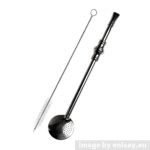
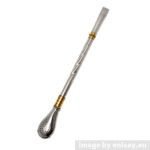
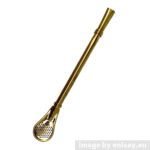
Coil and Spring Bombillas
These are also very common bombillas. The filtering mechanism is designed like a tightly coiled spring, with small slits that act as the filter. They generally clog less than some other types like the spoon bombilla, so they’re perfect for beginners or those who want a stronger flow of liquid. The slightly larger openings mean that sometimes a leaf or two will slip through, and they are not appropriate for very dusty mates (unless you enjoy the bitterness of the dust, in which case go for it!).
The difference between the coil and spring bombillas is that the coil version has a non-detachable, static filter, whereas the spring bombilla has a removable spring mechanism which makes cleaning much easier.
Our versions:
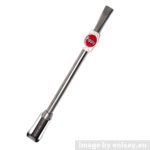
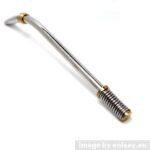
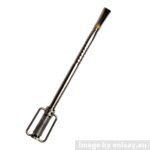
Ball Bombilla/Bulbilla
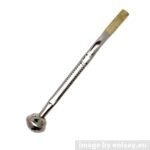 As the name implies, the filter of this bombilla comes in the shape of a ball or bulb. The filtering mechanism is similar to that of the spoon bombilla, with many small perforations dotted across the surface. In general, they function the same, but the shape might pose a few challenges.
As the name implies, the filter of this bombilla comes in the shape of a ball or bulb. The filtering mechanism is similar to that of the spoon bombilla, with many small perforations dotted across the surface. In general, they function the same, but the shape might pose a few challenges.
First of all, you might need a slightly larger gourd so as not to hit the walls when trying to mold the mate. The holes can also be a bit larger than those of the spoon bombillas, which can lead to more debris coming through (but also a stronger flow). If used with a small gourd, the spacing of the holes might also result in some liquid being left at the bottom of the gourd.
Pick/Scraper Bombilla
 This design is slightly unique, but very helpful when curing and taking care of your gourd (see our post about how to prepare and maintain your gourd). The filtering is done through small horizontal slats on the sides and works for all types of mate, just not the dustiest. The curved segment on the end, resembling a hockey stick, makes it very simple to slide beneath the mate in your gourd, but also to scrape out any remaining mate when done. It can also be used to scrape the sides of the gourd as part of the curing process.
This design is slightly unique, but very helpful when curing and taking care of your gourd (see our post about how to prepare and maintain your gourd). The filtering is done through small horizontal slats on the sides and works for all types of mate, just not the dustiest. The curved segment on the end, resembling a hockey stick, makes it very simple to slide beneath the mate in your gourd, but also to scrape out any remaining mate when done. It can also be used to scrape the sides of the gourd as part of the curing process.
Screw Bombilla
 This design is getting quite popular in Argentina and around the world. The filtering is done through slits similar to those of the pick bombilla. The main upside is that it’s very quick to take apart (by unscrewing the filter, hence the name) and reassemble for cleaning purposes. It’ll work well for any medium to rough grind mate, which includes most types of mate from Argentina.
This design is getting quite popular in Argentina and around the world. The filtering is done through slits similar to those of the pick bombilla. The main upside is that it’s very quick to take apart (by unscrewing the filter, hence the name) and reassemble for cleaning purposes. It’ll work well for any medium to rough grind mate, which includes most types of mate from Argentina.
Fanned Bombilla
Fanned bombillas are designed with a solid ring around a filter of narrow horizontal openings. The ring and narrow slits provide more resistance when pulling the liquid, leading to a slower, more concentrated drinking experience. The ring also helps with the molding of the mate.
Bamboo/Cane/Wooden Bombilla
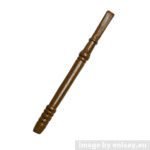 The most traditional of bombilla types, these types have very few advantages over modern metal bombillas. The placement of the holes can make it hard to reach the last parts of liquid at the bottom of the gourd, but they also often let small particles through, they can clog easily and they are prone to grow moldy.
The most traditional of bombilla types, these types have very few advantages over modern metal bombillas. The placement of the holes can make it hard to reach the last parts of liquid at the bottom of the gourd, but they also often let small particles through, they can clog easily and they are prone to grow moldy.
The one big upside is that there is no risk of burning yourself, as bamboo and wood do not transfer heat very well. However, this is honestly an unusual problem with modern metal bombillas anyway.
They look very authentic, though, and could be a fun novelty item in your bombilla collection.
MATERIALS
Now that we’ve looked at the main different designs of bombillas, let’s briefly discuss the most common materials used when making one. We’ve sorted these into two categories based on practicality and safety – generally recommended and generally not recommended (or only recommended for special occasions).
Recommended
Stainless steel – it’s cheap, does not rust and is very durable. It’s now the market standard and is perfect for a bombilla that you want to last you a lifetime.
Alpaca/German silver – a durable alloy consisting of copper, zinc and nickel. It’s fairly cheap compared to actual silver and is frequently used in South American jewelry. Take care if you have an allergy to either copper or nickel.
Silver – the preferred material when manufacturing high-end bombillas. It looks great and is extremely durable. Many silver bombillas are paired with gold in the beak. In earlier times, you see, it was believed that gold could kill germs.
Nickel – relatively durable and cheap. It might begin rubbing off after some time and could cause allergies in some people, so take some extra care.
Not recommended (or only in certain cases)
Cane, wood, bamboo – these materials do not transfer heat very well, but they do make the bombilla difficult to clean and likely to grow mold quickly.
Glass – looks very stylish and doesn’t transfer much heat, but is brittle and might break and hurt you. Remember: shards of glass are not a healthy additive to yerba.
Iron, tin – durable but transfers a lot of heat, so you might burn yourself. Iron is also very prone to rusting if not properly maintained.
CLEANING/TAKING CARE OF THE BOMBILLA
 In this last part of the article, we’ll take a look at how to properly take care of your bombilla. Appropriate care is vital if you want your favorite bombilla to last you as long as it deserves.
In this last part of the article, we’ll take a look at how to properly take care of your bombilla. Appropriate care is vital if you want your favorite bombilla to last you as long as it deserves.
The basic cleaning ritual is no different than that of your regular cutlery – just use dish soap and water, scrub it clean and rinse it off. If you’re in the mood for a deep cleaning, drop your bombillas in a pot of boiling water for several minutes to neutralize the bacteria. This can be particularly useful for bombillas with a flat beak, since using a bombilla brush might be quite tricky.
For the bombillas with round necks and a hole at the base, like most screw bombillas, use a bombilla brush to clear away any tough debris (it’s recommended to do this before use of any freshly bought bombilla, since some factories leave tiny metal particles inside, which could be dangerous).
There you go! We know that choosing the correct bombilla can be a tricky thing, and hopefully this post has helped you get an overview of some things to consider. As a rule, every type of bombilla has its uses, and it’s up to you to find your Chosen One! And don’t you worry, with all the variations out there you’ll find yourself building a booming bombilla collection in no time!
